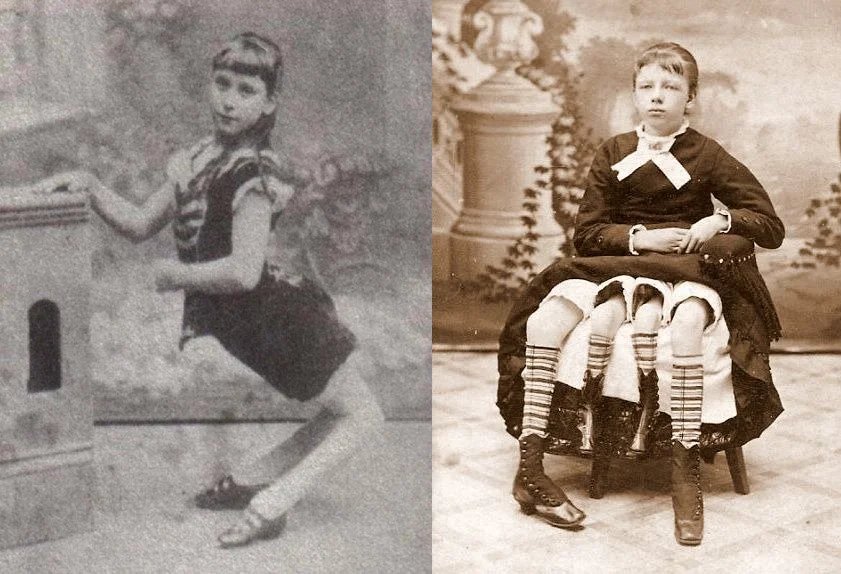Josephine Myrtle Corbin, the famous sideshow performer, was born in 1868 with a rare condition known as dipygus. This condition caused her to have two separate pelvises and pairs of legs. Remarkably, Josephine went on to lead a successful and intriguing life, captivating audiences with her unique anatomy. Her story is one of resilience and strength, defying societal norms and embracing her uniqueness with confidence. Join us as we delve into the fascinating life of Josephine Myrtle Corbin and uncover the extraordinary experiences that shaped her legacy.
The Incredible Life of Josephine Myrtle Corbin: The Woman with Two Sets of Reproductive Organs
Welcome to a fascinating journey into the life of Josephine Myrtle Corbin, a woman with a truly extraordinary story. Born in 1868, Josephine defied the odds and captured the attention of people worldwide with her unique condition. Let’s delve into the incredible life of this remarkable individual and learn more about her inspiring journey.
Early Life and Discovery of Her Condition
Josephine Myrtle Corbin was born on May 12, 1868, in Lincoln County, Tennessee. From a young age, it was evident that Josephine was different from other children. As she grew older, it became apparent that she had an unusual and rare medical condition that set her apart from everyone else.
At the age of 13, Josephine’s condition was discovered during a routine medical examination. Doctors were shocked to find that Josephine had not one, but two sets of reproductive organs. This condition, known as diphallia and dicephalus, is extremely rare, with only a few known cases in medical history.
Living with a Rare Condition
Despite the challenges that her condition presented, Josephine Myrtle Corbin embraced her uniqueness and lived a fulfilling life. She demonstrated incredible resilience and courage in the face of adversity, inspiring others with her positivity and strength.
Throughout her life, Josephine faced many difficulties and obstacles but never let them hold her back. She became a symbol of hope and perseverance, showing the world that differences should be celebrated rather than feared.
Medical Marvel and Public Curiosity
Josephine’s condition made her a medical marvel and a subject of public curiosity. People from far and wide came to see her, intrigued by her unique anatomy and intrigued by her story. Josephine embraced her role as a curiosity, using her platform to raise awareness about her condition and educate others about diversity and acceptance.
Despite the attention and scrutiny she faced, Josephine remained true to herself and continued to live life on her terms. Her courage and determination inspired generations to come, leaving a lasting legacy that still resonates today.
Legacy and Impact
Josephine Myrtle Corbin passed away in 1928, but her legacy lives on. She left behind a powerful message of resilience, acceptance, and self-love that continues to inspire people around the world. Her story serves as a reminder that we are all unique and valuable, regardless of our differences.
Today, Josephine Myrtle Corbin is remembered as a trailblazer and a symbol of strength. Her life is a testament to the power of perseverance and the importance of embracing diversity. As we reflect on her journey, let us carry forward her message of acceptance and love for all.
The Shocking True Story of the "Four-Legged Girl" | Josephine Myrtle Corbin
Frequently Asked Questions
Who was Josephine Myrtle Corbin?
Josephine Myrtle Corbin was a famous sideshow performer born in 1868, known for having two separate pelvises and four legs. This rare condition, known as dipygus, made her a unique attraction in the late 19th century.
How did Josephine Myrtle Corbin’s condition affect her daily life?
Despite her unusual anatomy, Josephine was able to lead a relatively normal life. She was able to walk and even became a mother, giving birth to five children. Her condition did pose some challenges, but she was able to adapt and live a fulfilling life.
Where did Josephine Myrtle Corbin perform during her career?
Josephine traveled with various sideshows and circuses, showcasing her unusual anatomy to curious audiences. She gained popularity for her unique condition and became a well-known figure in the entertainment industry during her time.
Final Thoughts
Josephine Myrtle Corbin, known for her rare medical condition of dipygus, led a remarkable life that challenged societal norms. Her story is a testament to perseverance and resilience in the face of adversity. Corbin’s unique anatomy fascinated people around the world, leaving a lasting impact on medical and social history. Today, she is remembered as a trailblazer who defied expectations and embraced her uniqueness. Corbin’s legacy serves as a reminder to celebrate diversity and individuality in all its forms.




